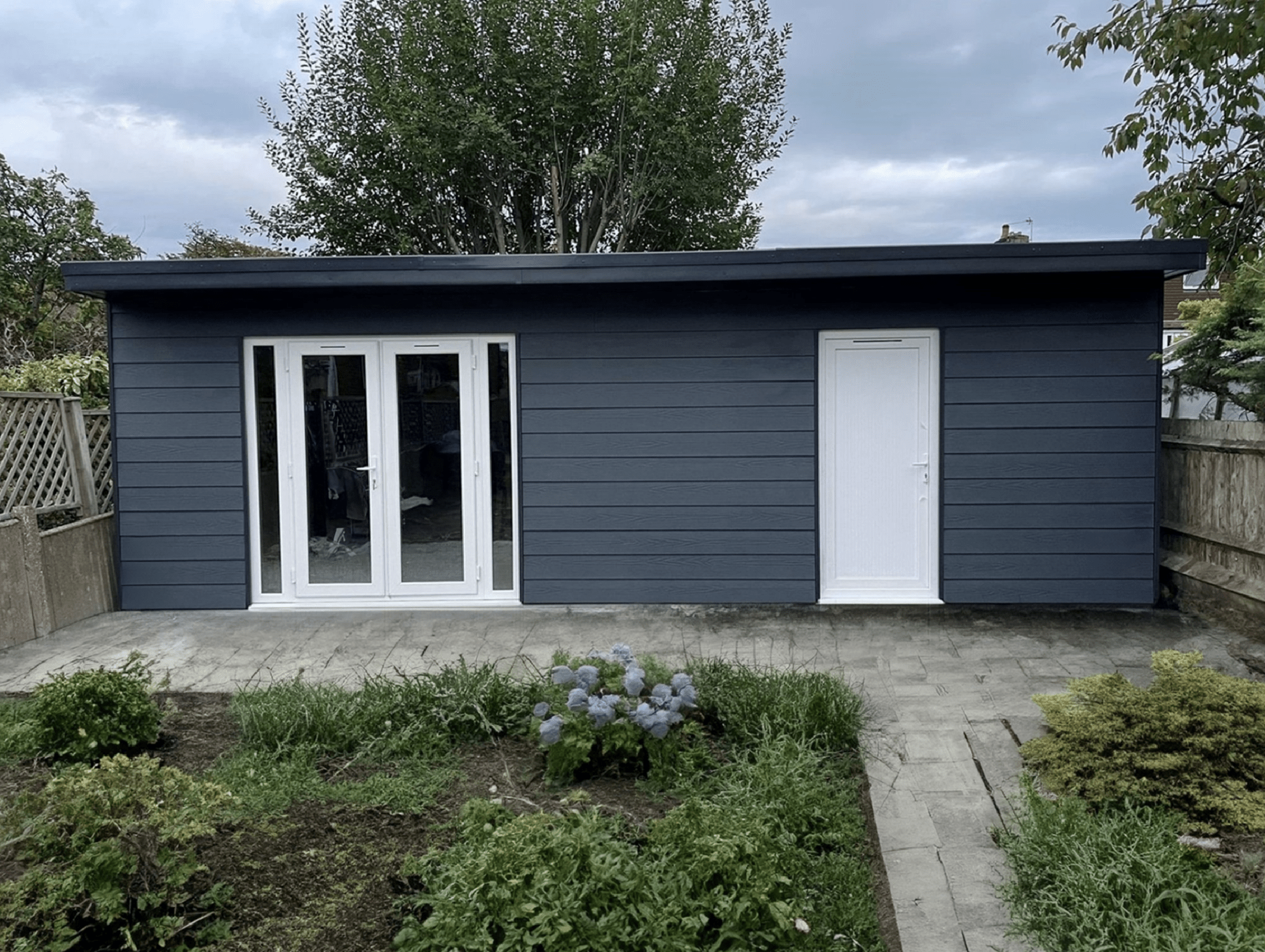Cladding serves as a critical layer of defence against the elements while making your property look good!
Whether constructing a new property or renovating an existing one, the accuracy in determining the amount of cladding required is important. Here atr Trade Warehouse, we supply plain composite cladding, woodgrain composite cladding, and fibre cement cladding.
This article explores the process of calculating the right quantity of cladding, ensuring that your investment is cost-effective.
Preliminary Considerations
Prior to starting a cladding project, you must consider the variety of materials available, each with its own coverage capabilities.
Factors such as durability, insulation properties, and the building's geographic location play pivotal roles in determining the quantity of cladding needed.
From weatherboard to stone and metal options, the choice of material will dictate the approach to measurement and calculation.
Understanding Cladding Coverage
Cladding is typically sold in panels, with dimensions that directly influence coverage rates.
Standard sizes allow for straightforward calculations; however, variations in panel dimensions can significantly affect the total coverage.
This section will guide you through understanding how coverage rates are established and the implications for their projects.
Calculating Wall Area
To start, you should arm yourself with a robust measuring tape or a digital laser measurer for extra precision. Starting at one corner of the building, measure the full length of the wall from corner to corner. Record this figure, ensuring it is noted in either meters or feet, consistent with the unit of measurement that will be used for the cladding materials.
Next, measure the height of the wall from the base at ground level to the eaves or the top of the wall where it meets the roof. For buildings with gable ends, the average height is calculated by measuring both the highest point and the eave's height, then finding the median of these two figures.
Once the length and height are determined, multiplying these dimensions will give you the total square area of the wall. However, this is not the final figure to be used for ordering cladding, as you must account for windows, doors, and other architectural features that do not require cladding.
For each window, measure the height and width and multiply to find the area. Do the same for doors. Add the total area of all windows and doors and subtract this from the total wall area previously calculated. This adjusted figure reflects the actual surface area requiring cladding.
It is also wise to consider other architectural features such as vents, utility boxes, or decorative elements that might influence the amount of cladding needed. Each feature must be evaluated and its area deducted from the total wall area.
In cases of irregular wall surfaces, such as those with recesses or protrusions, each section should be measured separately and calculated as an individual entity, then added or subtracted from the main wall area, as appropriate.
As an additional tip, it's advisable to conduct these measurements at different times of the day, as varying light conditions can help in spotting nuances in the building's architecture that might be missed in a single observation.
With the final, adjusted wall area in hand, you can proceed with confidence, knowing that the figure represents a true and accurate base from which to calculate the amount of cladding required, thereby avoiding the twin pitfalls of under- or over-ordering.
Cladding for Different Building Types
The cladding needs for residential structures differ from those of commercial buildings.
This section explores the unique requirements of various building types, taking into account the differences in design and scale.
The Role of Cladding Profiles
The profile of cladding—be it beveled, interlocking, or flat—can alter the quantity needed due to the way profiles interconnect or overlap. Understanding the influence of cladding profiles is essential for an accurate purchase order.
Waste Factor and Overage
Waste may arise from cuts, trimming, or damaged material during transportation or handling. Calculating an "overage" – additional material ordered to ensure that enough is on hand – is a protective step that guards against the unexpected and ensures that the project can proceed without costly delays or reordering.
An appropriate overage percentage takes into consideration several variables. For a standard project, an overage of 5-10% is commonly recommended. This accounts for the typical waste seen in cutting pieces to fit the exact dimensions of the walls, as well as the minor imperfections or damage that might occur.
However, if the cladding project involves intricate designs, numerous cuts, or a complex pattern, a higher waste factor might be necessary. For such projects, an overage of 10-15% or more may be wise. This allows room for the trial-and-error process that often accompanies the fitting of complex patterns and designs.
It is also important to factor in the skill level of the installers. Professional contractors with extensive experience in cladding might be more efficient, potentially reducing the waste factor. On the other hand, for those less experienced or DIY enthusiasts, a higher overage might be wise to compensate for potential mistakes that necessitate re-cuts or replacements.
Additionally, the type of cladding material can influence the overage calculation. Some materials, like stone or high-end composites, may have more inherent variability and can require a greater allowance for matching patterns or grain, thus increasing the waste factor.
For projects that will span over a significant period, considering potential product discontinuation or batch colour variation is also crucial. In such cases, securing an additional amount of cladding at the outset ensures that the entire project can be completed with the same material batch, avoiding noticeable discrepancies.
Lastly, when calculating overage, it's important to review the delivery and storage conditions. If the project site has limited storage and a high risk of material damage due to exposure to the elements or construction traffic, a higher overage will safeguard against the loss of materials before installation.
The Impact of Building Shape
The complexity of a building's shape can complicate cladding calculations. Simplistic structures require a straightforward approach, whereas buildings with intricate designs necessitate a more nuanced method of measurement.
Tools and Resources for Calculation
Accurate measurement is the cornerstone of cladding calculation.
Without precise dimensions, the risk of either underestimating or overestimating the material needed can lead to cost overruns or supply shortfalls.
Traditional tools like tape measures and laser distance meters are fundamental for physical measurement. A tape measure is suitable for smaller areas, providing a direct and tactile means to measure lengths and heights. For larger and more complex structures, a laser distance meter can quickly provide accurate measurements, even over long distances, and can be particularly useful for hard-to-reach areas.
Calculators specifically designed for cladding projects can also be indispensable. These calculators often allow users to input the dimensions of the walls, along with variables such as the percentage for overage and the size of the cladding materials. They can automatically adjust for doors, windows, and other features, providing a more tailored material estimate.
For more advanced and detailed planning, CAD (Computer-Aided Design) software can be employed. These programs allow for the creation of a detailed 3D model of the project area, where measurements can be incredibly precise. Moreover, CAD software can simulate the placement of cladding, giving a visual representation of how the finished project will look and an exact count of the required material.
In addition to standalone tools, many suppliers offer their own proprietary estimation software or apps. These may be tailored to their specific product lines and can sometimes offer the most accurate estimates for projects utilizing their materials. They often include a feature to directly order the calculated amount of cladding, streamlining the procurement process.
Professional Assessment and Advice
There are scenarios where the expertise of a professional is invaluable. This portion of the article emphasizes the importance of consulting with an expert, particularly for complex projects.
Ordering Cladding Material
Once the necessary quantity of cladding is determined, the next step is placing an order. This part guides readers through the ordering process, including tips on ensuring the quantity is confirmed with suppliers.
Legal and Regulatory Considerations
Building codes and local regulations are pivotal in the planning stages of cladding projects. This segment underscores the necessity of compliance to avoid legal pitfalls.
Cost Implications
Budgeting for cladding must take into account the potential for variance in quantity. This section offers strategies for optimizing material costs and highlights the consequences of inaccurate estimations.
Environmental Considerations
Environmental impact of building materials is a growing concern in the UK construction world. The environmental considerations of cladding encompass the entire lifecycle of the materials used — from sourcing to installation, and beyond to disposal or recycling.
Sustainable sourcing is the first critical step. It involves selecting cladding materials that are harvested or manufactured in an environmentally responsible manner. This means looking for suppliers who prioritise the use of recycled materials, adhere to renewable energy practices in production, and maintain standards that minimize the impact on natural habitats.
The manufacturing process of cladding materials also warrants attention. The energy consumption and emissions associated with production can vary significantly between materials. For instance, the production of certain metal claddings may require high levels of energy and emit a substantial amount of greenhouse gases. On the other hand, materials like recycled steel or sustainably sourced timber have a lower environmental footprint.
The installation process itself can also contribute to a project's environmental impact. Efficient planning to minimize waste, responsible disposal of offcuts, and choosing low-impact installation methods can all reduce the environmental toll of a cladding project.
Post-installation, the ramifications of excess material should be considered. Overordering not only has financial implications but also results in surplus materials that can become environmental burdens. Proper estimation and order quantities are essential to prevent this. When excess does occur, it's important to have a plan for the leftover materials — whether that be a storage plan for future repairs, donations to local building projects, or ensuring the materials are recyclable.
Furthermore, the long-term performance of cladding can have environmental implications. Materials that offer better insulation can reduce energy consumption in a building, leading to a decrease in fossil fuel use and carbon emissions. The durability of cladding also plays a role; materials that last longer reduce the need for replacement and, consequently, the environmental impact of manufacturing new materials.

